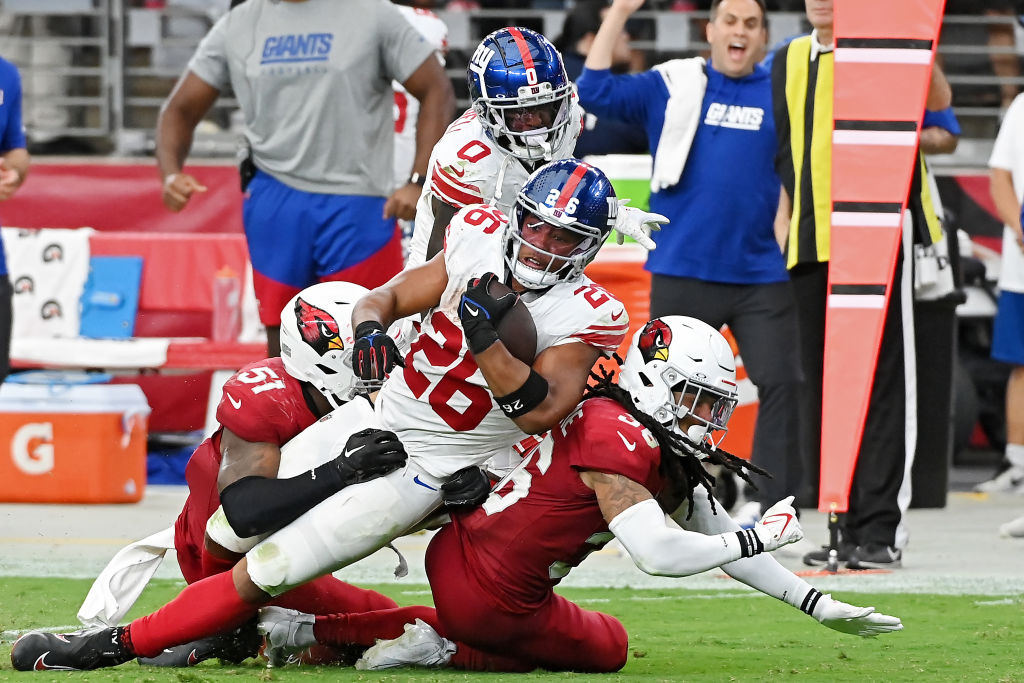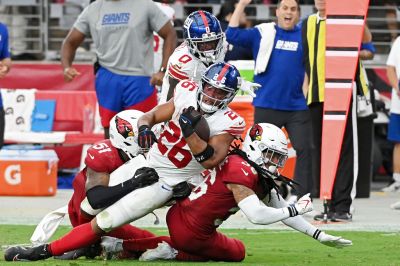Last month, the Detroit Lions unveiled a statue of their star running back from the 1990s, Barry Sanders, outside the team’s stadium. It’s hard to imagine a running back from recent decades—from any team—receiving such an honor. An electrifying back, the Hall of Famer competed in an era when running backs were among the most important players on an NFL squad. From 1990 through 2000, a running back won the AP’s most valuable player award five times. It’s happened only three times since then, most recently in 2012. In the meantime, their compensation has been drastically outpaced by players at other positions.
While their pay has not kept pace, running backs play arguably the most brutal position in a violent sport, leaving them damaged goods in the eyes of general managers when it comes to a second contract. No matter their talent or how many yards they rack up, it doesn’t matter when it comes to dividing up the NFL cash pie; they get the table scraps.
During the offseason this year, running backs’ pay gripes took center stage, as stars like Saquon Barkley and Josh Jacobs threatened holdouts before accepting basically what had been on the table previously. Top quarterbacks make more than $50 million a year, and leading wide receivers and defensive ends hit nearly $30 million annually. The best running backs, meanwhile, are lucky to clear $10 million. But that’s just the stars. The average NFL running back made $2.2 million in 2022, well behind quarterbacks ($6.25 million) and squarely between place kickers ($2.95 million) and punters ($1.65 million).
A group of running backs, including Barkley and Jacobs, hosted a call among themselves and with the NFLPA this summer to no avail, and the NFL filed an arbitration grievance against the union for seeming to suggest RBs should feign injury to make a contract point.
So why are running backs so devalued? Can anything be done to change the paradigm?
“Analytics have proven over and over again that there is little difference between a Pro Bowl RB and a mid-round rookie in terms of points added to an offense,” Mike Tanier, a longtime football writer now with The Messenger, tells me via direct message. “Even anecdotal evidence is full of unknown backups replacing stars with little to no dropoff (and) rookie RBs are more ready to play than rookies at other positions, and there is more available talent: 20-25 draftable RBs per (draft) class.”
Take last Sunday’s epic Miami Dolphins game, in which the South Florida team put up 70 points, the most in an NFL game since 1966. The team had conducted ultimately unsuccessful trade talks with the Indianapolis Colts during the preseason about their disgruntled star running back Jonathan Taylor, who wants a new contract. So who was the star of the 70-point explosion? A little-known rookie running back, De’Von Achane, a third-round pick who gained 233 yards rushing and receiving and scored four touchdowns. His base salary this season is the rookie minimum, $750,000.
The NFL began moving from a run-first league to passing one as far back as the 1970s, but until recent years teams still prized running backs, who were frequently among the top picks in the draft. That changed as analytics increasingly showed passing a more effective weapon than running. From 2011 to 2022, an average of fewer than four teams out of the 32 ran more plays than they threw per season, according to fantasy football site FF Today.
The NFL is the richest league in the world by many measures. The Green Bay Packers, the only public team, reported $68 million in operating profits on $610 million of revenue. And the Packers are, well, middle of the pack when it comes to team revenue in the NFL. So why not just pay the running backs more?
Well, the NFL has a collective bargaining agreement with a salary cap per team. Any money taken to pay running backs has to come from other players. There was even talk a few years ago of running backs forming their own bargaining unit, but it's hard to see how that could work in practice.
There are a few solutions that could help. Running backs, because they are constantly plowing into a line of larger men, get injured more frequently and have shorter careers than their counterparts. But initial contract lengths are the same for all players taken in a given draft round. First round picks get a four-year guaranteed contract with a club option for a fifth. And after that the club can use what is known as a franchise tag, a device a team can use once a year to lock in a player not under contract.
By the time a running back gets through all that, his career is already in the backstretch. “The rookie contract structure keeps RB salaries fixed through most to all of their peaks,” Tanier wrote in his message. “A 4th year WR can demand $100-mill. A 4th year RB might have 2 good seasons left.”
The next CBA could shorten the contract terms just for running backs, or base the term on the average length of the position’s career. The labor deal, which doesn't expire until March 2031, could also disallow using the franchise tag on running backs. Of course all of this would have to be collectively bargained and the league would want something in return. Would the union give up something just for the running backs?
Part of the problem too is the very term running back: Many are known for their pass catching skills. But even if they end up as the third or fourth top pass catcher on the team, they get paid like a running back. In 2014, tight end Jimmy Graham brought a grievance over his franchise tag designation, which required the team to pay him the average of the top five players at his position. He argued his pay should be determined at a wide receiver's level. He lost.
The arbitrator in that case ruled that tight ends’ blocking duties made the role distinct from wide receivers. A running back’s ground attack, of course, makes the position different from a wide receiver too. But when Austin Ekeler of the Los Angeles Chargers can catch 107 passes in 2022, fifth most in the league and far and away the most on his team, but get paid at running back levels, something is awry.
Perhaps there are glimmers of hope. Two running backs were taken among the first 12 picks in the 2023 NFL draft: Bijan Robinson eighth by the Atlanta Falcons and Jahmyr Gibbs 12th by the Detroit Lions. And the highest paid running back is Christian McCaffrey, who makes $16 million a year and is a crucial linchpin in the offense of the San Francisco 49ers, a Super Bowl favorite.
With the salary cap set to rise exponentially in coming years as new broadcast deals come into play and their contract accelerators trigger each year, maybe a little more of the lucre can be handed off to running backs.






Please note that we at The Dispatch hold ourselves, our work, and our commenters to a higher standard than other places on the internet. We welcome comments that foster genuine debate or discussion—including comments critical of us or our work—but responses that include ad hominem attacks on fellow Dispatch members or are intended to stoke fear and anger may be moderated.
With your membership, you only have the ability to comment on The Morning Dispatch articles. Consider upgrading to join the conversation everywhere.